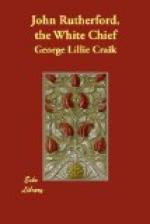The New Zealanders conceive, also, that what we call a shooting star is ominous of the approaching dissolution of any one of their great chiefs who may be unwell when it is seen. Like the vulgar among ourselves, too, they have their man in the moon; who, they say, is one of their countrymen named Rona, who was taken up long ago, one night when he went to the well to fetch water.
Nicholas has given us, on the authority of his friend Duaterra, the most particular account that has appeared of the inferior deities of New Zealand. Their number, according to him, is very great, and each of them has his distinct powers and functions; one being placed over the elements, another over the fowls and fishes, and so of the rest. Deifications of the different passions and affections, also, it seems, find a place in this extended mythology.
In another part of his work, Nicholas remarks, as corroborative of the Malay descent of the New Zealanders, the singular coincidence, in some respects, between their mythology and that of the ancient Malay tribe, the Battas of Sumatra, whose extraordinary cannibal practices we have already detailed; especially in the circumstance of the three principal divinities of the Battas having precisely the same functions assigned to them with the three that occupy the same rank in the system of the New Zealanders.[BK]
FOOTNOTES:
[Footnote BJ: Marae. With Maoris and Samoans the word means an open space in a village; in the Tahitian, Mangaian, and Paumotan languages it means a temple, or a place where rites were performed.]
[Footnote BK: The religion, and superstitions and legends of the Maoris are dealt with in Sir George Grey’s “Polynesian Mythology,” Mr. S. Percy Smith’s “Hawaiki,” articles by Mr. Elsdon Best in the “Transactions of the New Zealand Institute,” articles by that author and by Mr. Percy Smith in the “Journal of the Polynesian Society,” Mr. E. Tregear’s “The Maori Race,” and Mr. J.C. Andersen’s “Maori Life in Ao-tea.”]
CHAPTER X.
It is very remarkable that the New Zealanders attribute the creation of man to their three principal deities acting together; thus exhibiting in their barbarous theology something like a shadow of the Christian Trinity. What is still more extraordinary is their tradition respecting the formation of the first woman, who, they say, was made of one of the man’s ribs; and their general term for bone is hevee, or, as Professor Lee gives it, iwi[BL] a sound bearing a singular resemblance to the Hebrew name of our first mother.
[Illustration: Christchurch Museum.
Carved boxes (waka-papa, or waka) for
holding feathers and trinkets.
The upper box is said to have formed part of Captain
Cook’s collection.]
Particular individuals and places would also seem to have their own gods. When the “Active” was in the river Thames, a gale of wind, by which the ship was attacked, was attributed by the natives on board to the anger of the god of Shoupah,[BM] the Areekee who resided in the neighbourhood. Korro-korro, who was among them said that as soon as he got on shore he would endeavour to prevail upon the Areekee to propitiate the offended deity. When Marsden asked the people of Kiperro[BN] if they




